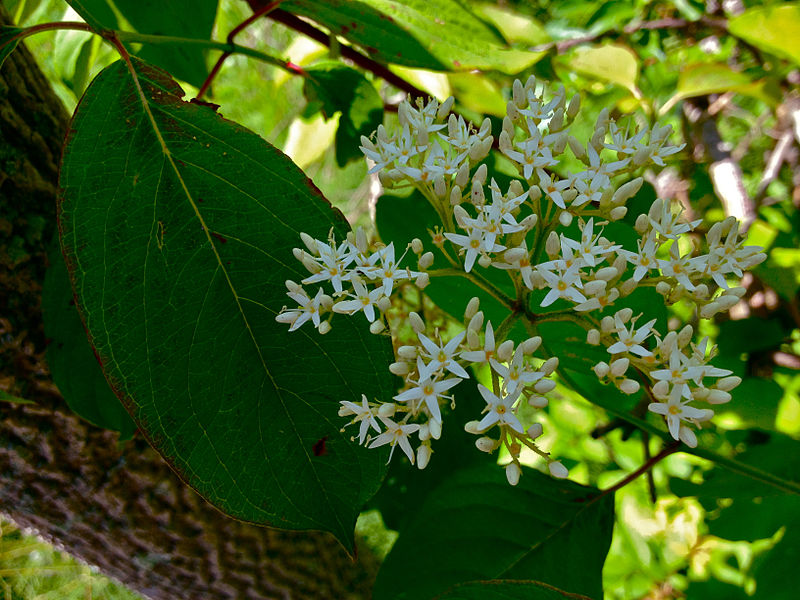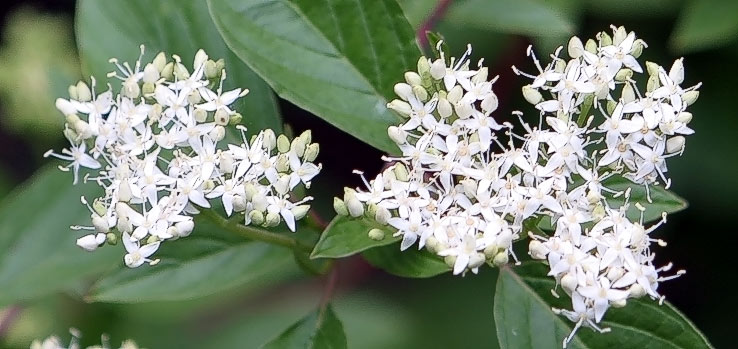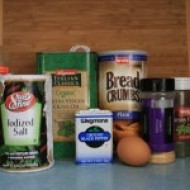
The following is a “guest” post from my hubby- the guy who really knows his plants around here. We recently thought we spotted elderberries at a friend’s house- but Tim’s discerning eye second guessed our initial identification. Read on to find out how to distinguish these two look-alike plants from each other.
Elderberries are ripening this time of year where we live, so if you have any interest in harvesting these berries, it is as good a time as ever to nail down your elderberry identification skills. Black Elderberry (sambucus nigra) shrubs are pretty distinctive, but if you are not paying close attention to what you are seeing, mistaking other plants for them is not impossible. At certain stages of development, a couple plants in particular appear the closest of all to Elderberry: the Silky Dogwood (cornus amomum) and the Redosier (Red Osier) Dogwood (cornus sericea). To complicate the trouble of precisely identifying Redosier Dogwood in contrast to the Silky Dogwood, Redosier is a variable species, which essentially means that its morphology is not always the same–different specimens can look different from each other. For our purposes, though, that is not very important; we are trying to distinguish the Dogwoods from Elderberry, not so much from each other.
If you take the time to google “elderberry look-alikes,” your search results will likely include references to Water Hemlock and Pokeberry–the former deathly poisonous and the latter arguably poisonous if used improperly. Aside from the risk-factor of mistaking those plants for Elderberry (which has its own share of toxicity-risks), there is almost no reason to fear mistaking Water Hemlock or Pokeberry for Elderberry. Those two plants are markedly different from Elderberry in fairly obvious ways–I won’t go into them in detail now, but suffice it to say, when identifying a plant, don’t hinge your identification on only one feature (e.g. berries, drupes or flowers growing in cyme patterns). Pay attention to the overall habit of the plant–the location, the time, duration, and color of the flowers (if any), whether it is woody or herbaceous, the pattern and color of the bark, a general sampling of the leaves–opposite, alternate, whorled–from many parts of the plant, the shape, margins, and vein structure of the leaves, the characteristics of the fruit, etc. If you observe carefully and thoroughly, and especially if you begin to learn the vocabulary of kingdom Plantae and attach deeper meaning to your sensory experience of these objects, you will gradually become more accurate in plant identification.
Having said that, let’s return to the Silky Dogwood. Here’s a close-up of its lovely flower cyme (that’s the name of that cluster pattern):

And here’s the Redosier Dogwood:

For comparison, here is the Black Elderberry bloom:

Certainly these flower clusters look similar. But that is not the only similarity they share (I’ll get to the differences in a moment). They both tend to grow in wet locations–though both are very tolerant plants–so you may even find them growing together (as we did recently).
The main thing that makes these Dogwoods more likely candidates for elderberry confusion than other look-alikes like Pokeberry and Water Hemlock is the fact that they too are shrubs of very similar proportions (from 6-10′ high) to elderberry. Look at the Silky Dogwood for example:

And here, the Black Elderberry:

Clearly there are differences between them, but at least we are dealing with similar types of plants. The most conspicuous distinguishing features between these Dogwoods and the Elderberry, however, are in the leaves and the fruits. Elderberry leaves are compound. Silky Dogwood and Redosier Dogwood leaves are simple. Elderberry leaf margins are toothed. The dogwood leaves are smooth. Study the following images to note the differences between the Elderberry leaf on the left and the Redosier Dogwood leaves on the right:
 Observe also the following drawings of the Dogwoods and Elderberry courtesy of the USDA Plant Profiles.
Observe also the following drawings of the Dogwoods and Elderberry courtesy of the USDA Plant Profiles.
Silky Dogwood (cornus amomum):

Redosier Dogwood (cornus sericea):

And finally, Black Elderberry (sambucus nigra):

Let’s turn to the berries and drupes. Note first the density and size of the cymes in both dogwoods as compared to the elderberry. The dogwoods’ cymes are smaller and less dense than the elderberry’s (obviously the presence of berries or drupes will depend on fertilization), but the dogwoods’ drupes are larger than elderberries. Also be aware of the color of the fruit (this is one of the best ways to discern whether you’re dealing with a silky or redosier, too). At least where we live, elderberries ripen to a rich deep purple well before the silky or redosier fruits ripen. Thus, if you see ripe elderberries side by side with a dogwood, you should see that the dogwood fruits are still green. Observe the following photo; Redosier in the foreground, Elderberry in the background (just a few of the elderberries are starting to turn purple):
 Finally, a note about the color of the dogwood fruit: Redosier fruit turns whitish when ripe while Silky Dogwood’s is blueish. See the following images.
Finally, a note about the color of the dogwood fruit: Redosier fruit turns whitish when ripe while Silky Dogwood’s is blueish. See the following images.
Silky Dogwood:

Redosier Dogwood:
And finally, just for contrast, Black Elderberry:
So, to recap, pay close attention to these distinguishing features:
| Leaves | Leaf Margins | Fruit Color when Ripe | Time of ripening | |
| Sambucus Nigra | Compound | Toothed | Deep Purple | Late July–September |
| Cornus Amomum | Simple | Smooth | Blue | Around September |
| Cornus Sericea | Simple | Smooth | White | After September |
I hope at least some of this information is helpful. Do remember–if you are not sure what a plant is, first work hard to figure it out (because maybe you’ll learn something new). If you can’t figure it out with reasonable confidence, then don’t eat it for now–you’ll probably get another opportunity in the future!







Pingback: How to Grow a Jelly Garden | Tenth Acre Farm
I know that elderberry grows in the wild in our area (coastal RI) but I’m a true novice at plant id. Having done some research, because I’d really prefer avoiding Water Hemlock, I did learn some helpful ID information, not discluding this post. My greatest challenge is that I’m just now seeing what may or may not be elderberries (just a handful) and there are no leaves for comparison. I’ve followed the stem down and it does appear to be bark-like with no nubs. Where the berries appear it is reddish, which visually seems to be consistent though I haven’t see this mentioned? At any rate, would it be overly assumptive to ask if I might ? be able to email you a picture to peek at with your more knowledgeable eyes? Or even if you know a good plant ID FB group to direct me to? I belong to a plant ID group already, but they’re pretty persnickety and don’t seem very warm to newbies like myself.
Danielle,
Thanks for asking your question! Do you know what USDA hardiness zone you are in? After a quick search, it seems that the warmest coastal RI zone you could be in is 7b. If you are just seeing a handful of berries now, I would guess that they are not elderberries at this point as elderberries have likely long since ripened and disappeared from the plant by now. However, there is a slight possibility that there could be a few desiccated berries clinging on at this point. The best way for me to tell would be if you sent along a few pictures to theyrenotourgoats@gmail.com. It does become more difficult to ID without leaves on the plant, but a few pictures of the overall plant, the bark, the berries, and the stems would help.
Absolutely a fantastic read. I started foraging 3 years ago. Progressing each year. Last fall I spotted Elderberry and I’ve been following the plant all year. This page gave me a 99% confidence level.
Once I learned about hemlock, Queen Anne’s lace there is no comparison. No other sites, I’ve read have referenced dog woods.
No one else I know forages. May I send a couple pictures.
Thank you SO much! I’m so glad it was helpful! Certainly, you can send a couple of pictures to theyrenotourgoats at gmail dot com. I’ll be on the lookout!
Thank you so much! I have started my first nature journal and was unsure as to what type of plant and berries I had so I could label it correctly. Your post was perfect – I now know that I have a Redosier Dogwood. 🙂
So glad it was helpful! 🙂
This is very very helpful! The thing is, we are experiencing a terrible infestation of box elder bugs that are living in the wood siding of my house and I cannot keep up with removing them and I refuse to poison then as it wouldn’t be safe for my kids,cats or chickens. The only other solution I have is to remove the tree, which there are two of but the one is my favorite part of my yard. It’s so pretty ask year round and I can see it from almost every room in my house. Wold you please look at a few photos to help me identify this tree because I want to be fairly positive is an elder tree before I consider removing it. Thanks!
Certainly! Send them along to theyrenotourgoats at gmail dot com and we’d be happy to take a look.
Diatomaceous earth is a natural insecticide for Box Elder Bugs. I know from experience.
Oh I so enjoyed the read. You explained it so well and with the pictures to go with it help so much. I was given and elderberry and I assumed it grew like a big bush or tree and I was told it did but I didn’t know it had runners. So mine is still in the pot and I’m trying to figure out what I should do. Should I plant in the back or along the woods etc. but I’m new to this and your article help me and my husband a lot. We were out there with my phone checking that plant to see how the leave look. Now I have a plant growing along the property line that made flowers and all and Grows like a huge bush. So I’m gonna go see if it’s an elederberry. That’s another reason I look up to see what is good and which is bad. I had heard you have to be careful because you might think it’s elderberries and it’s not. So your article help. Thanks :))
Hello there,
I am not sure if I have elderberry in my backyard, or if it is something else? Could I send you an image somehow?
Thank you!
Hi Rahel! I received your email and I’m about to reply to it! Thank you!
Pingback: 17 Elderflower Recipes for a Summertime Treat | Homestead Honey
What about blue elderberry? They look almost identical to silky dogwood when the fruits ripen?
Hi Val- sorry for the delay! We’ve been away from the blog for a bit. I would start by checking other features besides the berries. The leaves of elderberries should still be compound and toothed, while the leaves of dogwood should be simple and smooth edged. Also, you can compare the size of the berries and the shape of the cymes. When in doubt, we recommend watching a plant for an entire season to observe its development. You can also check with the local state extension office in your area!
Pingback: What is Elderflower? Benefits of Elderflower & 25 Recipes!
Pingback: Elderberry Identification and Foraging Tips | HealthyGreenSavvy
So, in simplist terms, is the difference in the leaves?
Elderberry has the ratchet ridges in the leaves and the dogwood has smooth sided leaves?
My dogwood which looks like kousa has berries like elderberry splatting my deck with purple dye. The birds love them . I’m confused 🤔